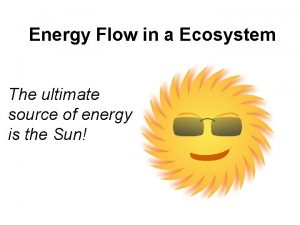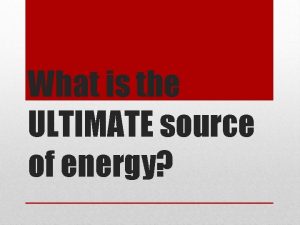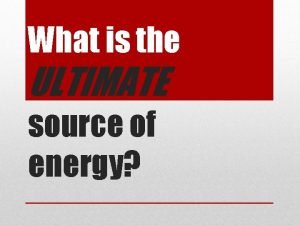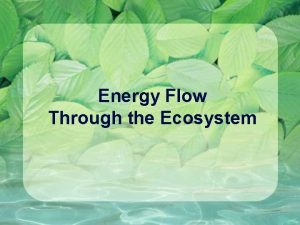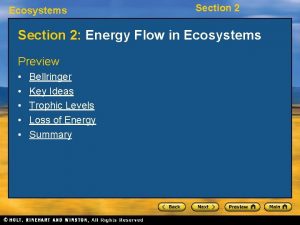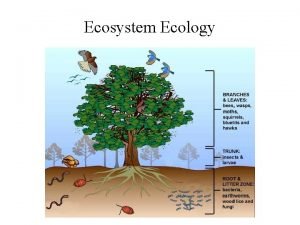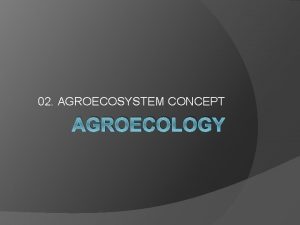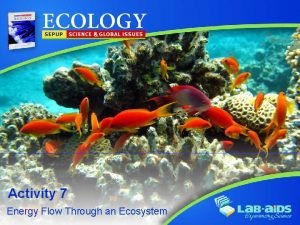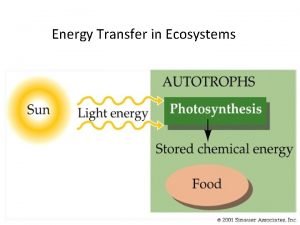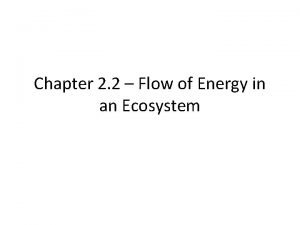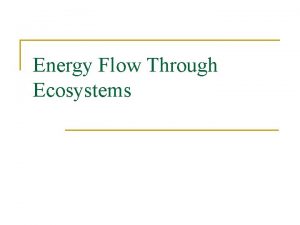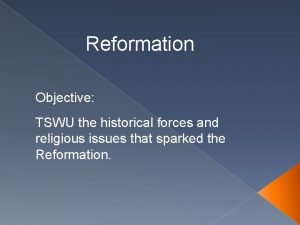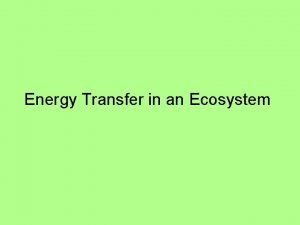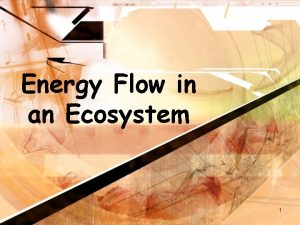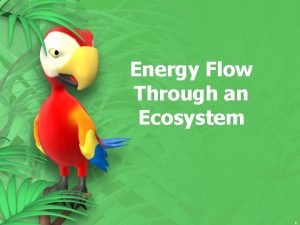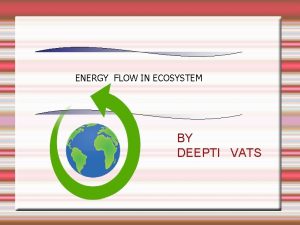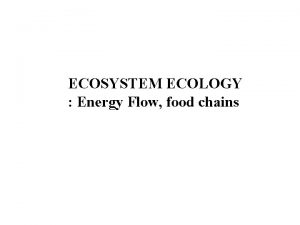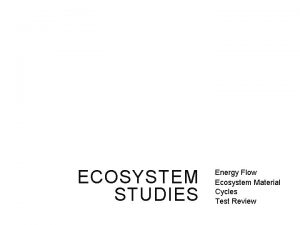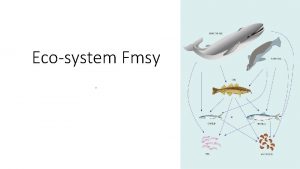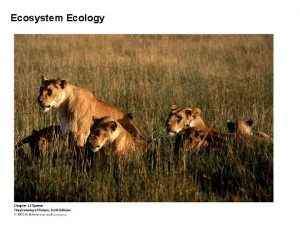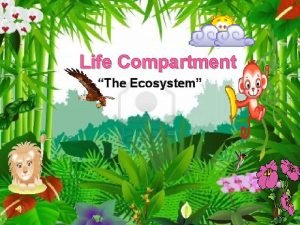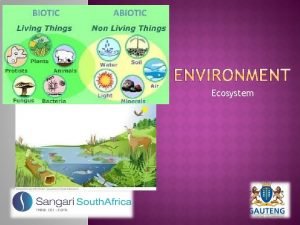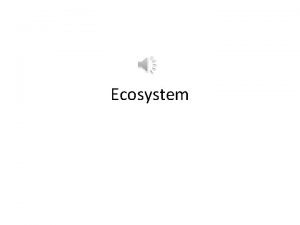Energy Flow in a Ecosystem The ultimate source















- Slides: 15

Energy Flow in a Ecosystem The ultimate source of energy is the Sun!

How does energy from the Sun enter the ecosystem? • PHOTOSYNTHESIS - Plants use the Sun’s energy to make sugars. 6 CO 2 + 6 H 2 O + sunlight C 6 H 12 O 6 + 6 O 2

ENERGY IN AN ECOSYSTEM • Producer (autotroph) = makes its own food through photosynthesis (self-feeder). Ex: grasses, trees, flowering plants, algae • 100% of energy available

Where does energy made by the producer go? • CELLULAR RESPIRATION - ingested food is broken down into energy C 6 H 12 O 6 + 6 O 2 6 CO 2 + 6 H 2 O + energy

ENERGY IN AN ECOSYSTEM Primary Consumer (heterotroph) = eats producers and produces energy through cellular respiration AKA - Herbivore = PLANT EATER (Ex: zebra, cow) • 10% of energy available Producer (autotroph) = makes its own food through photosynthesis (selffeeder). Ex: grasses, trees, flowering plants, algae • 100% of energy available

ENERGY IN AN ECOSYSTEM Secondary Consumer (heterotroph) = eats primary consumers (cellular respiration) AKA: Carnivore=MEAT EATER (Ex: tiger, wolf ) Omnivore = PLANT & MEAT EATER (Ex: human, bear) • 1% of energy available Primary Consumer (heterotroph) = eats producers, and produces energy through cellular respiration AKA - Herbivore = PLANT EATER (Ex: zebra, cow) • 10% of energy available Producer (autotroph) = makes its own food through photosynthesis (selffeeder). Ex: grasses, trees, flowering plants, algae • 100% of energy available

• Which teeth do you think are meat-eaters? • Which teeth do you think are plant-eaters? • What type of diet do the human teeth indicate?

ENERGY IN Tertiary Consumer (heterotroph) = eats secondary consumers (Ex: owl, shark) AN ECOSYSTEM *May be the APEX PREDATOR (top of food chain) • 0. 1% of energy available Secondary Consumer (heterotroph) = eats primary consumers (cellular respiration) AKA: Carnivore = MEAT EATER (Ex: snake, wolf ) OR Omnivore = PLANT & MEAT EATER (Ex: human, bear) • 1% of energy available Primary Consumer (heterotroph) = eats producers, and produces energy through cellular respiration AKA - Herbivore = PLANT EATER (Ex: rabbit, cow) • 10% of energy available Producer (autotroph) = makes its own food through photosynthesis (selffeeder). Ex: grasses, trees, flowering plants, algae • 100% of energy available


Food Chains vs. Food Webs • Food Chain = a sequence of energy transfer as each organism eats another organism.

Food Chains vs. Food Webs An ecosystem is more complex than a simple food chain. Most organisms eat more than one type of food. Food Web = a complex sequence of energy transfer showing multiple feeding relationships.

Energy pyramids show each trophic level (step in a food chain) is supported by the previous level. Why does the population decrease as the trophic levels increases?

What about the dead stuff? • Decomposers- Break down dead organisms in an ecosystem and return nutrients to the soil, water, and air Ex: mushroom, shrimp, bacteria

TERTIARY CONSUMER (heterotroph/carnivore) 0. 1% of energy available SECONDARY CONSUMER (heterotroph / carnivore) 1% of energy available PRIMARY CONSUMER (heterotroph / herbivore) 10% of energy available PRODUCERS (autotroph) 100% of energy available

ENERGY IN AN ECOSYSTEM
 Ultimate source of energy in an ecosystem
Ultimate source of energy in an ecosystem The ultimate source of energy in food is
The ultimate source of energy in food is How many trophic levels are there
How many trophic levels are there How does energy flow through the ecosystem
How does energy flow through the ecosystem Chapter 2 section 2 flow of energy in an ecosystem
Chapter 2 section 2 flow of energy in an ecosystem Energy flow and material cycling in ecosystem
Energy flow and material cycling in ecosystem Agroecosystem concept
Agroecosystem concept Energy flow in ecosystem
Energy flow in ecosystem Describe the flow of energy in the kelp forest ecosystem.
Describe the flow of energy in the kelp forest ecosystem. Energy transfer in ecosystem
Energy transfer in ecosystem Principles of ecology 2 flow of energy in an ecosystem
Principles of ecology 2 flow of energy in an ecosystem How does energy flow in an ecosystem
How does energy flow in an ecosystem Energy roles in an ecosystem
Energy roles in an ecosystem How does energy flow through an ecosystem
How does energy flow through an ecosystem Anglicanism beliefs
Anglicanism beliefs Energy naturally flows from warmer matter to cooler matter.
Energy naturally flows from warmer matter to cooler matter.
